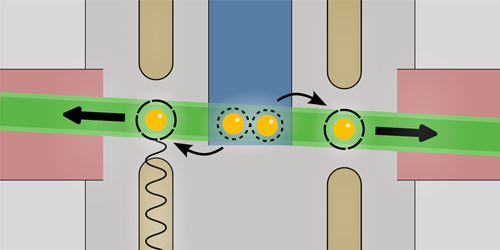Cooper-Pair Splitting on Demand
Many quantum technologies rely on separating and interrogating entangled particles. Superconductors already come with a supply of paired-up entangled electrons—the Cooper pairs that give these materials their transport properties. However, extracting and separating them on demand is a challenge. Now theorist Christian Flindt of Aalto University in Finland and his collaborators have shown that the splitting of Cooper pairs can be accurately controlled using time-dependent voltages [1].
A Cooper pair comprises two electrons whose spins are entangled and point in opposite directions. In existing Cooper-pair splitters, these electrons, once split, tunnel into separate quantum dots, or artificial atoms. However, this process has proved noisy, uncontrollable, and therefore unsuitable for most applications. Flindt and his collaborators propose a way to make the splitting of Cooper pairs much more reliable.
The key to the operation of their proposed device lies in the multitasking of its electrodes, which define two quantum dots, one on each side of a superconducting strip. These electrodes draw Cooper pairs to the tip of the superconductor and separate them. They also set the energy levels in the two quantum dots so that each dot can readily accept a separated electron before passing it on through a nanowire. Importantly, the voltage applied to the electrodes on one side varies periodically in time in such a way that exactly two Cooper pairs are split and emitted in each period of the drive.
Using realistic values for materials and components, Flindt and his collaborators estimate that their on-demand Cooper-pair splitter could operate in the gigahertz range. They also speculate that yoking several of them together could form the basis of a quantum computer than runs on entangled electrons.
–Charles Day
Charles Day is a Senior Editor for Physics Magazine.
References
- F. Brange et al., “Adiabatic Cooper pair splitter,” Phys. Rev. B 109, L081402 (2024).




